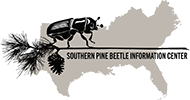Abstract
A field study was conducted to evaluate the response of Dendroctonus frontalis and Dendroctonus mexicanus to two commercially available semiochemical lures (1) frontalin + α-pinene, (2) frontalin + blend of α-pinene and β-pinene + endobrevicomin, and to know the relative abundance of both species in an altitudinal gradient. The study was carried out on pine-oak forests within the Sierra Gorda Biosphere Reserve, in the state of Queretaro, Mexico. Study sites were on an altitude gradient of 1,672 to 2,530 m asl. Semiochemicals were attached to 12-unit Lindgren funnel traps hung from non-host trees, and bark beetles were collected biweekly
during 1 year. The identification of the species was based on external characters as well as on the form of genitalia. The response to the treatments was determined through an analysis of variance at a 0.05 level of significance, followed by a Tukey- Kramer mean comparison test. The abundance of D. frontalis and D. mexicanus was different in response to the two semiochemical lures. Frontalin + blend of α-pinene and β-pineno + endo-brevicomin attracted 30 times more bark beetles than frontalin + α-pinene. On the other hand, both species were found coexisting at all five elevation points; however, D. frontalis was more abundant from 1,672 to 2,040 m asl, while D. mexicanus was more abundant from 2,291 to 2,530 m asl. These results have implications for monitoring and mass trapping these two pine bark beetle species since for each 100 specimens captured in traps baited with frontalin + α-pinene, 3,000 would be captured if frontalin + blend of α-pinene and β-pineno + endobrevicomin is used. That means 30 times more time and effort for insect identification and counting. Therefore, if the objective of a trapping system is to detect the presence of D. frontalis and D. mexicanus, or to determine the flight periodicity of these species in an area of interest, it is sufficient to use frontalin + α-pinene. On the other hand, if we aim to complement sanitation cutting to help control small infestations, or to avoid bark beetle dispersion from infested logs in log collection centers, it is more appropriate to use frontalin + endo-brevicomin + blend of monoterpenes, with the necessary measures to avoid spill over the attacks.
To read the full article please visit the link below:
Sanchez-Martinez, Guillermo, and Jose Francisco Resendiz-Martinez. 2020. “Response of Dendroctonus Frontalis Zimmerman and Dendroctonus Mexicanus Hopkins(1) to Two Semiochemical Lures in the Sierra Gorda of Queretaro, Mexico.” Southwestern Entomologist 45 (2): 511–20. https://doi.org/10.3958/059.045.0219.
